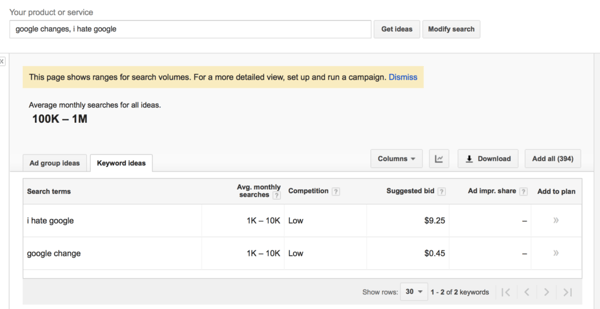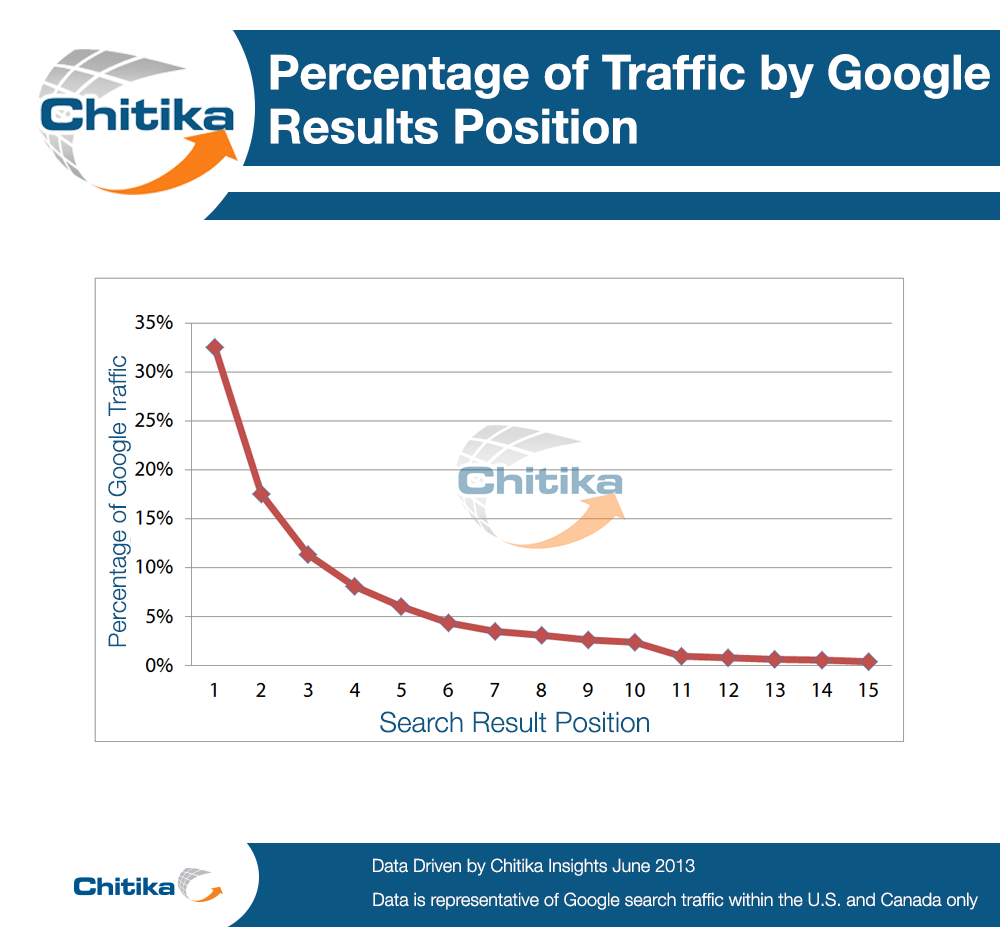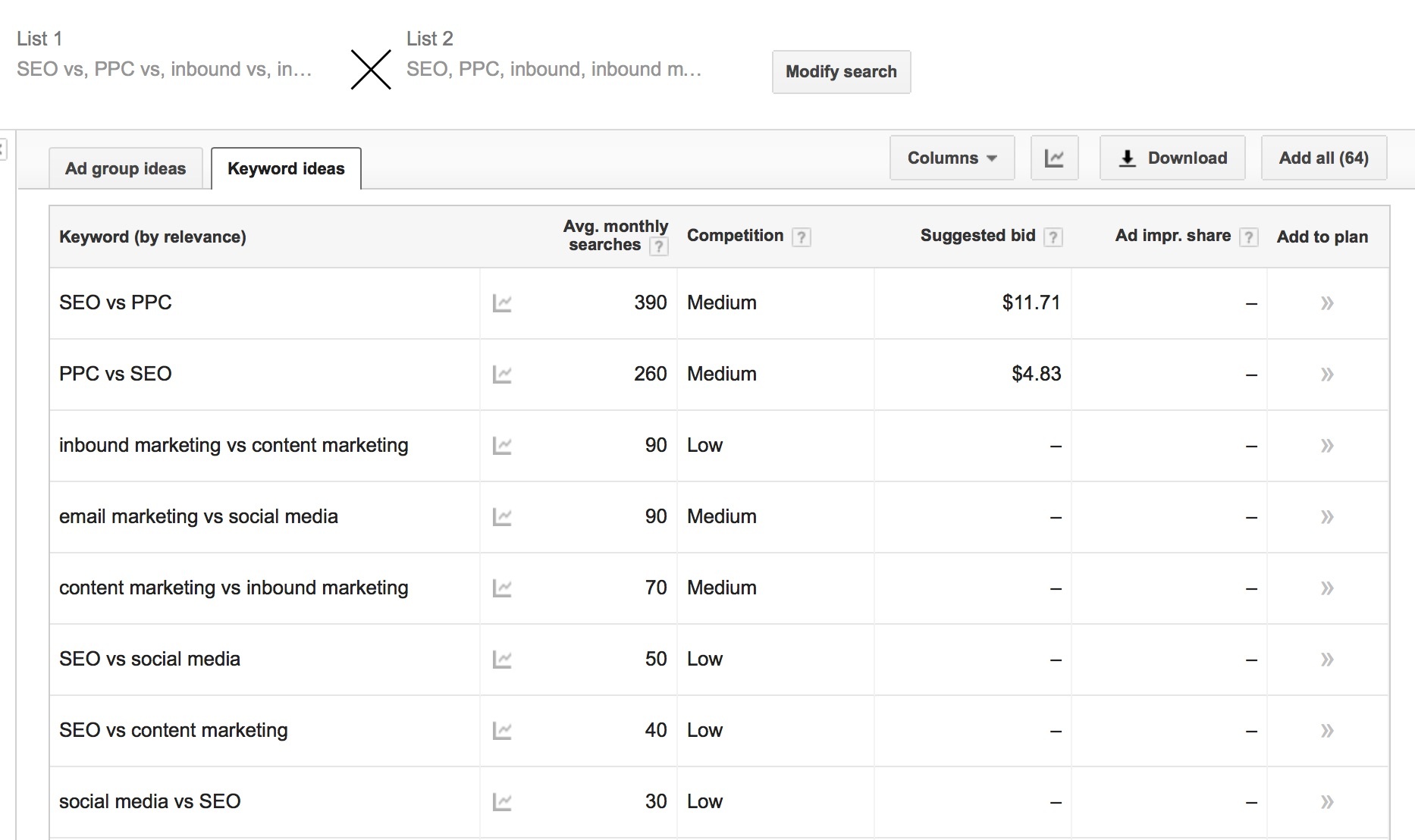2 Quietly Massive Updates To Google's Keyword Planner

Sometimes Google likes to tell us when they make changes, and sometimes they don’t. When you have that much power, I guess you do as you please.
But two of the more recent Google Keyword Planner changes are whoppers, and I didn’t see any official update. If your job is even tangentially related to SEO, content, inbound, or anything with words on the internet, I recommend getting up to speed (or at least passing this along to whoever does your company’s keyword research).
Update 1: Combined Search Volume For Related Keywords
When The Change Was Made: Summer 2016
Back in the summer, I noticed that Google’s Keyword Planner listed the exact same search volumes for related keywords. I did some research and saw chatter starting to pick up.
Here’s an example:
- “Cyber breaches”: 1,800 searches per month.
- “Cyber attacks”: 1,800 searches per month.
- “Cybersecurity breach”: 1,800 searches per month.
Takeaways
If you missed the update, you’d likely be overestimating search volume by a ton. Whereas it used to be each phrase’s individual monthly search volume, it’s now the total of all related phrases.
In addition, you could be missing some of those related keywords that are counted toward the new total. In the example above, what if “cyber threats” was also included in the 1,800, but your keyword research didn’t include that phrase? The three phrases you decided to write about—”cyber breaches,” “cyber attacks,” and “cybersecurity breaches”—might actually have a total closer to 1,100.
Jennifer Slegg from TheSEMPost provided a good framework for which keywords Google might consider related:
- Plurals with non-plurals for any word in the keyword phrase.
- Acronyms with longhand version.
- Stemming variants: -er, -ing, -ized, -ed, etc., keywords (i.e., designer, designing, designed).
- Words that can be spelled with or without space (i.e., car park and carpark).
- Words with and without punctuation (i.e., kid toys and kid’s toys).
I’d also add “synonyms” to that list. That’s a much more ambiguous category, but I’ve seen Google consistently consider them the same term. For example, the words “marketing companies,” “marketing agencies,” and “marketing firms” would all have the same search volume.
Final Thoughts
This is a big loss for anyone who does keyword research. But most importantly, this update is actually already hidden as a result of the second update I’ll cover below! It’s important for you to know that these summed search volumes are still being used behind the scenes, but they’re no longer visible. It’s almost more dangerous for keyword researchers.
Let me explain.
Update 2: Search Volume Ranges For Low AdWords Spenders
When The Change Was Made: Fall 2016
Just about a week ago, I noticed that now we’re receiving only search volume ranges in Keyword Planner. (That’s what triggered this post.)

Takeaways
Google is rolling this out in phases, and you may not even see it yet. Here’s what you need to know:
- The ranges are huge (0, 1-100, 100-1,000, 1,000-10,000, 10,000-100,000, 100,000-1 million, 1 million and up). It’s really hard to tell if it makes sense to try to rank for a keyword based on your company’s goals.
- The only way to get actual volume rather than ranges is to become a big-time AdWords customer. Yep, that’s right. Google can spin this however they want, but that’s the reason. On top of that, no one knows yet just how much you need to spend per month to get back to non-ranges.

For this update, Google did have an employee quietly announce the change. You can read about the details in Matt Southern’s article on SearchEngineJournal. I recommend it.
Final Thoughts
As I plan inbound strategy for clients, I’d say the biggest drawback is the size of the ranges. If a group of keywords totaled 10,000 searches per month, I’d plan to write about it. If it had 1,000, I wouldn’t. That’s because 1,000 to 10,000 searches is all in one range now.
Impact & Our Plan
Let’s revisit what Google has taken away from us as a result of these two updates:
- In the Spring of 2016—before these updates—we would’ve gotten 880 searches per month (I’m making that number up) for “cyber attacks.” That would represent the exact search amount per month for that exact term.
- In the Summer of 2016—after the first update—we’d get 1,800 searches per month for “cyber attacks.” That’s the total for all keywords related to that phrase.
- In the Fall of 2016—after the second update—we now get 1,000 to 10,0000 searches per month for “cyber attacks.”
- Said differently: Good luck.
My take is that the first update wasn’t a big deal. We try to get pages and articles to rank for a topic that brings in the right visitors rather than a specific keyword phrase. So if we rank for the term “inbound agency,” I’ll gladly target and rank for “inbound company” and “inbound firm” as well.
But the second update really impacts our content planning. What if we instituted a rule that said we’d take the middle of the range as a rule of thumb, but most of the keywords we targeted actually fell toward the bottom of the range? We’d end up underperforming against expectations for that set of keywords. Visitors and leads would be lower as a result.
The only new process I can think about implementing is a feedback loop. I’ll start to look at existing traffic for certain blog posts and estimate search volume for that group of keywords based on the number of monthly visitors. That will give me an indication of where the keyword group falls within the range Google provides.
Other than that, let’s cross our fingers and hope Google scraps this idea.



